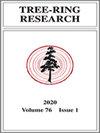黄松林林分密度急剧增加后,氮素会限制林分的生长
IF 1.1
4区 农林科学
Q3 FORESTRY
引用次数: 1
摘要
自20世纪初以来,整个美国西部的黄松林发生了极端的林分密度增加,对生长、生理功能和死亡风险产生了不利影响。在茂密的森林中确定大型、古老的上层树木的主要压力源可以为管理决策提供信息,以促进恢复力和生存。以新墨西哥州北部的黄松原生林为研究对象,研究了不同密度下林分密度增加对林分年轮生长的影响以及水分和氮的相对影响。我们测量了林分密度增加前、密度增加后气候相似时期和最近向干旱过渡期间树木的年轮生长和碳辨别。我们预计密度驱动的水分胁迫会导致密集林分中上层树木年轮生长的减少。通过树木年轮、叶片氮浓度和土壤氮供应的碳同位素判别,我们发现茂密林分的生长受到抑制,死亡率更高,但氮而非水限制生长。在茂密林分中,有效氮的减少限制了光合速率,导致细胞内13c的同化减少,树木年轮生长缓慢,与气候的关系减弱。这一意想不到的结果表明,多种限制因素可以影响森林动态,因为密度驱动的氮限制与水分胁迫相互作用,影响树木的生长和生理功能。本文章由计算机程序翻译,如有差异,请以英文原文为准。
NITROGEN CAN LIMIT OVERSTORY TREE GROWTH FOLLOWING EXTREME STAND DENSITY INCREASE IN A PONDEROSA PINE FOREST
ABSTRACT Extreme stand density increases have occurred in ponderosa pine forests throughout the western U.S. since the early 20th Century, with adverse implications for growth, physiological functioning, and mortality risk. Identifying primary stressors on large, old overstory trees in dense forests can inform management decisions to promote resilience and survival. We tested the impact of stand density increase on overstory tree-ring growth, and the relative influence of water and nitrogen, in an old-growth ponderosa pine forest in northern New Mexico subject to variable density increase. We measured annual tree-ring growth and carbon discrimination in trees before stand density increased, in a climatically-similar period post-density increase, and in recent transition to drought. We expected density-driven water stress to drive reduced tree-ring growth in overstory trees in dense stands. We found reduced growth and higher mortality in dense stands, but nitrogen rather than water constrained growth, as determined by carbon isotope discrimination in tree rings, leaf nitrogen concentration, and soil nitrogen supply. In dense stands, less available nitrogen limited photosynthetic rate, leading to reduced assimilation of intracellular 13 C and higher discrimination with low tree-ring growth and a reduced relationship with climate. This unexpected result illustrates that a variety of limiting factors can influence forest dynamics, as density-driven nitrogen limitation interacts with water stress to influence tree growth and physiological functioning.
求助全文
通过发布文献求助,成功后即可免费获取论文全文。
去求助
来源期刊

Tree-Ring Research
农林科学-林学
CiteScore
2.40
自引率
12.50%
发文量
15
审稿时长
>36 weeks
期刊介绍:
Tree-Ring Research (TRR) is devoted to papers dealing with the growth rings of trees and the applications of tree-ring research in a wide variety of fields, including but not limited to archaeology, geology, ecology, hydrology, climatology, forestry, and botany. Papers involving research results, new techniques of data acquisition or analysis, and regional or subject-oriented reviews or syntheses are considered for publication.
Scientific papers usually fall into two main categories. Articles should not exceed 5000 words, or approximately 20 double-spaced typewritten pages, including tables, references, and an abstract of 200 words or fewer. All manuscripts submitted as Articles are reviewed by at least two referees. Research Reports, which are usually reviewed by at least one outside referee, should not exceed 1500 words or include more than two figures. Research Reports address technical developments, describe well-documented but preliminary research results, or present findings for which the Article format is not appropriate. Book or monograph Reviews of 500 words or less are also considered. Other categories of papers are occasionally published. All papers are published only in English. Abstracts of the Articles or Reports may be printed in other languages if supplied by the author(s) with English translations.
 求助内容:
求助内容: 应助结果提醒方式:
应助结果提醒方式:


